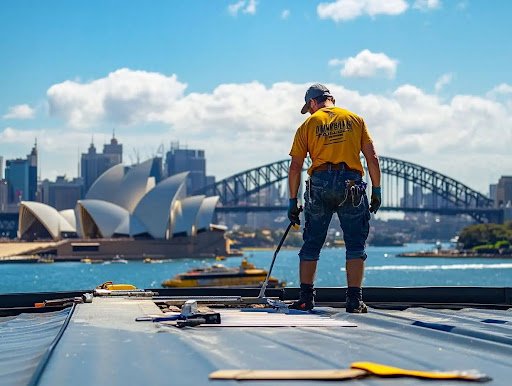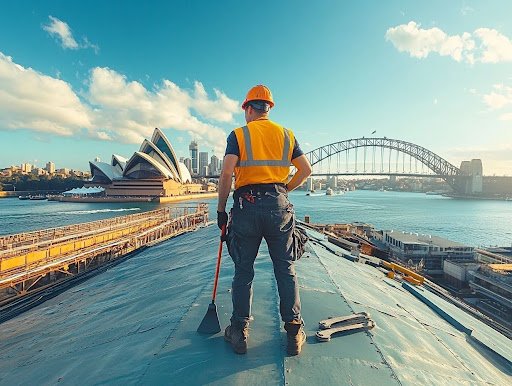How to Maintain a New Roof in Sydney
- Trusted Roofing Professionals Sydney
- Free Quotes Available
- Contact Us Now
Maintaining a new roof is essential for homeowners in Sydney, where varied weather conditions can significantly affect its integrity and longevity. Elements ranging from intense sunlight to heavy rainfall can considerably impact roofing materials, making regular maintenance imperative. This guide will address the importance of roof maintenance, outline practical steps to ensure durability, discuss common roofing materials, and identify signs indicating that your roof may require attention. By understanding how to maintain your roof effectively, you can safeguard your investment and ensure its optimal condition.
Key Takeaways:
- Regularly maintaining a new roof in Sydney is crucial due to the extreme weather conditions.
- Maintaining a new roof in Sydney includes inspection, cleaning, repairing any damage, applying protective coating, and regular maintenance checks.
- Choosing the right roofing material for your home and regular maintenance checks can prolong the lifespan of your new roof in Sydney.
Why is Maintaining a New Roof Important in Sydney?
Maintaining a new roof in Sydney is essential for ensuring the structural integrity of a home, safeguarding against weather-related issues, and extending the lifespan of roofing materials. Given Sydney’s diverse climate, homeowners must remain vigilant regarding the potential risks of water damage, leaks, and moisture accumulation, which can adversely affect the aesthetics and safety of their property.
Regular maintenance addresses minor concerns before they develop into significant problems and improves energy efficiency, resulting in long-term savings on heating and cooling costs for both residential and commercial buildings.

What are the Weather Conditions in Sydney?
Sydney has a temperate climate characterised by warm summers and mild winters, which significantly influences the durability and maintenance of roofs throughout the city.
Average summer temperatures reach approximately 26°C, while winter lows typically hover around 8°C. This distinct temperature fluctuation can impact various roofing materials. Humidity levels in the region can fluctuate considerably, often exceeding 60%, resulting in conditions that may exacerbate moisture retention. Such moisture retention creates an ideal environment for mould growth and contributes to the deterioration of various roofing materials.
- Rainfall: Sydney receives an annual average of approximately 1,200 mm of rain, the majority of which occurs during winter.
- Temperature Variations: The contrast between summer and winter can place stress on roofs, potentially leading to leaks and cracks.
Different roofing materials exhibit varied responses to these climatic conditions. For instance, while metal roofs may withstand some moisture-related issues, tile roofs can be susceptible to cracking due to thermal stress. Understanding these climatic patterns is essential for homeowners to maintain the integrity of their roofs effectively.
How do the weather conditions affect roofs in Sydney?
The varied weather conditions in Sydney can significantly affect roofs, as they encounter challenges such as excessive moisture and elevated temperatures that may lead to considerable damage over time.
Storms can be unpredictable and result in heavy rainfall and strong winds, further exacerbating roofing issues and compromising roofing surfaces. During periods of heavy rain, homeowners may observe distress signals such as curling shingles, cracked tiles, or even leaks. These indicators often suggest underlying problems that can escalate if not addressed promptly. Regular inspections are essential for early identification of such issues.
Key inspection areas should include:
- Examination around chimneys and vents for signs of wear.
- Assessment of gutters for debris that may cause blockages and pooling.
- Monitoring for algae or moss growth indications can signify moisture-related problems.
Implementing proactive measures can lead to significant savings in future repair and maintenance costs, preserving the integrity of the roofing system.
What Are the Steps to Maintaining a New Roof in Sydney?
Maintaining a new roof in Sydney requires adherence to several essential procedures to extend its lifespan and ensure its effectiveness in withstanding the elements. Each procedure, ranging from comprehensive inspections to routine cleaning, plays a crucial role in preventing water damage, leaks, and moisture accumulation that could jeopardise the structural integrity of the roofing system.
Implementing a systematic maintenance schedule enables the identification of potential issues at an early stage, thereby reducing the likelihood of costly repairs and ensuring the roof remains in optimal condition.
Step 1: Inspecting the Roof for Potential Issues
The initial step in maintaining a roof in Sydney is to conduct a comprehensive inspection to identify any signs of damage, roof leaks, or potential moisture problems that could escalate into more significant issues if not addressed promptly.
During this inspection, homeowners should meticulously examine for loose tiles, which may indicate age, wear, or potential damage due to weather conditions. It is also essential to observe any signs of water damage, such as discolouration or mould, as these can signal underlying leaks that jeopardise the home’s structural integrity.
Over time, Common issues may arise, including structural concerns, moisture build-up, and damaged flashing. Therefore, it is imperative to engage a professional contractor in this process. Professionals possess the necessary expertise and tools to conduct a thorough evaluation and offer appropriate recommendations for repairs or maintenance, thereby ensuring the roofing system’s longevity.

Step 2: Cleaning the Roof
Cleaning the roof is an essential maintenance task to prevent debris, moss, and mould accumulation. These substances can retain moisture and lead to significant damage over time, ultimately affecting the longevity of roofing materials and the home’s overall structural integrity. Regular maintenance enhances aesthetic appeal and ensures functionality, protecting against potential leaks and costly repairs.
Implementing effective cleaning techniques tailored to various roofing materials can significantly improve the roof’s overall condition. The following recommendations are suggested:
- Asphalt Shingles: Use a soft brush with a mild detergent solution to gently remove dirt and moss.
- Metal Roofs: A low-pressure washer can efficiently clean metal surfaces; ensure that the spray is directed downwards to prevent water from seeping underneath.
- Tile Roofs: A mixture of water and vinegar can safely eliminate algae and moss without damaging the tiles.
Safety is of the utmost importance for both internal and external maintenance. When working at heights, it is advisable to wear appropriate gear, including gloves and non-slip shoes, and consider using a safety harness.
Regular cleaning not only maintains the roof’s aesthetic quality but also contributes to its functionality, thereby preventing long-term issues.
Step 3: Repairing Any Damage and Assessing Future Needs
Addressing any damage identified during the inspection, such as replacing missing tiles, repairing leaks, and considering potential roof replacement, is essential for maintaining the integrity of roofs in Sydney.
Plus, these immediate repairs, homeowners often encounter various types of roofing material issues that necessitate attention for both structural and aesthetic reasons. Common repairs include:
- Flashing repairs: Preventing water infiltration around chimneys and vents.
- Deteriorated underlay: Providing secondary protection against leaks and water damage.
- Moss and algae removal: Preserving aesthetics and preventing further decay.
Each of these repairs typically involves using materials such as bitumen tiles, metal flashing, or specialised sealants, and may require the expertise of a professional contractor like Andy Quinn or services from companies like Five Star Roofing or BIM Sydney.
While do-it-yourself solutions may suffice for minor issues, it is critical to consult a professional roofing contractor when faced with extensive damage or when specialised expertise is required. This approach ensures that the repair work is effective but also safe and compliant with local building regulations.
Step 4: Applying Protective Coating
Applying a protective coating to a roof represents a prudent initiative that can significantly enhance durability, improve energy efficiency, and safeguard against moisture penetration, particularly in the variable climate of Sydney.
The longevity of a roof can increase markedly with the implementation of appropriate protective measures. Various types of protective coatings are available, each designed to meet the specific requirements of different roofing materials. Below are some standard options:
- Acrylic Coatings: These coatings are flexible and straightforward to apply. They offer excellent UV resistance and waterproofing capabilities, ideal for a strong roof structure.
- Silicone Coatings: Renowned for their moisture resistance, these coatings are particularly suitable for regions experiencing heavy rainfall.
- Polyurethane Coatings: Known for their high durability, these coatings are ideal for roofs subjected to foot traffic.
When contemplating the application of these coatings, it is advisable to conduct a thorough inspection of the roof to identify and rectify any existing damage before application. Depending on the type of roofing and the selected coatings, engaging professional services for installation can ensure a practical application, thereby enhancing the overall performance and longevity of the roof.
Step 5: Regular Maintenance Checks
Conducting regular maintenance checks is essential to ensure that the roof remains in optimal condition, enabling the identification of minor issues before they escalate into significant, costly problems.
It is advisable to schedule these inspections at least twice a year, preferably during the spring and autumn, to correspond with seasonal changes that may impact the roof’s integrity. During these assessments, various components should be thoroughly evaluated, including:
- Tiles or roofing materials for indications of wear or damage
- Flashing, ensuring its integrity to prevent water leaks
- Gutters and downpipes to confirm they are free of debris
- Ventilation systems to mitigate heat build-up in the attic
Engaging a professional contractor guarantees that the assessments are comprehensive and that any findings adhere to safety standards. A contractor’s expertise and knowledge are invaluable when detecting concealed issues that may not be apparent to an untrained observer, much like Andy Quinn’s Five Star Roofing services.

What Are the Common Roofing Materials Used in Sydney?
In Sydney, homeowners have a diverse selection of roofing materials, each offering distinct aesthetics, durability, and energy efficiency advantages.
Standard options include shingles, tiles, and metal roofing, each with unique installation and maintenance benefits and considerations.
A thorough understanding of the characteristics associated with these materials will enable homeowners to make informed decisions that align with their specific needs and preferences.
What Are the Pros and Cons of Each Material?
Each roofing material used in Sydney presents its advantages and disadvantages, which homeowners must carefully evaluate when selecting the most suitable option for their roofing needs.
In determining the best choice, key attributes such as lifespan, initial investment, maintenance requirements, and the roofing material’s contribution to the home’s overall aesthetics must be considered, much like choosing a reliable builder. A comprehensive understanding of these factors can significantly influence the satisfaction associated with the decision.
The chosen roofing material impacts the home’s durability against adverse weather conditions and also reflects the homeowner’s personal style. Consequently, homeowners must ensure they are thoroughly informed before making a decision that could have long-term implications for their properties.
- Durability: Different materials provide varying levels of resilience, with metal frequently recognised as the most enduring option.
- Cost: Initial expenditures can vary widely, affecting the overall roofing budget.
- Maintenance: Ongoing maintenance requirements differ, with certain materials necessitating more effort to maintain optimal condition.
- Aesthetic Appeal: The visual impact of roofing selections is vital in influencing property value and enhancing kerb appeal.
How to Choose the Right Roofing Material for Your Home in Sydney?
Selecting the appropriate roofing material for a home in Sydney necessitates careful consideration of various factors, including energy efficiency, aesthetic appeal, climate compatibility, and budgetary limitations.
In pursuing an ideal roofing solution, it is essential to reflect on the specific weather patterns of the area as well as the overarching architectural style of the residence. For instance, properties situated in coastal regions may be subjected to harsher weather conditions and therefore require more resilient materials, whereas those in temperate climates may prioritise insulation efficiency.
Personal preferences also play a significant role in the decision-making process. Some homeowners may favour natural materials for their warmth and authenticity, while others might choose modern synthetic alternatives that offer enhanced durability and reduced maintenance requirements.
Key considerations include:
- Local climate conditions
- Architectural consistency
- Individual preferences
Ultimately, consulting with a knowledgeable roofing contractor, such as BIM Sydney, can yield invaluable insights and tailored recommendations, ensuring a well-informed decision that withstands the test of time.
What Are the Signs of a Roof in Need of Maintenance?
Recognising the signs of a roof in need of maintenance is essential for preventing costly repairs and extending the lifespan of your roof in Sydney, especially when considering ventilation systems and plumbing impacts.
Maintaining vigilance in observing your roof can help avert future complications and financial burdens. Homeowners should be particularly attentive to the common indicators of roof problems, which can manifest in various forms. The following are key signs to monitor:
- Water stains on ceilings or walls may indicate potential leaks.
- Missing tiles that expose the roof to the elements.
- Persistent leaks that disrupt daily activities and cause damage over time.
To monitor these signs effectively, it is recommended that regular inspections be conducted after severe weather events or at least biannually. Promptly addressing these issues is critical, as delaying repairs can lead to more severe complications and significantly increase repair costs.

How Often Should a New Roof Be Maintained in Sydney?
In Sydney, routine roof maintenance should be conducted at least once a year, with additional inspections following severe weather events or significant temperature fluctuations.
By adhering to a consistent maintenance schedule, homeowners can substantially extend the lifespan of their roofs, thereby ensuring the integrity of the entire property is preserved. Several factors may influence the frequency of these essential inspections, including:
- Type of roofing materials used
- Local weather conditions
- Age of the roof
- Presence of overhanging trees
Engaging a qualified roofing contractor is crucial in developing a customised maintenance plan that addresses these factors and meets specific needs. This collaboration offers numerous advantages, such as tailored inspection protocols, early detection of potential issues, and overall peace of mind, as it ensures that the roof remains in optimal condition throughout the year.
Finding a Professional Roofing Service in Sydney
Identifying a professional roofing service in Sydney is crucial for ensuring high-quality installations, repairs, and ongoing maintenance of your roof.
When selecting a roofing contractor, prioritising a reputable service provider can significantly impact the longevity and durability of your roofing system. To protect yourself from potential liabilities, it is advisable to begin by verifying their credentials, including licences and insurance.
Experience is another vital consideration; seek contractors with a proven track record in the roofing industry to ensure you make a prudent choice. Customer reviews and testimonials can provide valuable insights into their reliability and quality of work, so it is wise to review these evaluations online, starting with an estimate from a reputable service like Five Star Roofing.
- Specialisation: It is important to find contractors who have experience with specific roofing materials, such as tiles, metal, or shingles, to ensure they possess the appropriate skills for your requirements.
- Warranty: Inquire whether they offer warranties on their work to safeguard your investment.
Ultimately, a thorough evaluation of these factors will assist in making an informed decision, ensuring that you secure a dependable partner for all your roofing needs.
The Importance of Regular Roof Maintenance in Sydney
Regular roof maintenance in Sydney is crucial for safeguarding residential properties from potential damage and ensuring the roofing system’s longevity. This practice gives homeowners peace of mind in the face of various environmental elements.
Conclusion: Keeping Your Roof in Top Condition in Sydney
In conclusion, maintaining your roof in optimal condition in Sydney enhances your home’s safety and structural integrity and preserves its aesthetic appeal and market value.
Regular inspections and prompt repairs prevent minor issues from developing into significant, costly problems. Homeowners should recognise the importance of engaging professional contractors who offer valuable expertise and experience in the maintenance process. BIM Sydney provides exceptional service to ensure your roof remains durable and efficient. Selecting appropriate materials suited to the specific climate and roofing style can significantly impact durability and performance. Implementing an ongoing maintenance plan can result in long-term savings by extending the roof’s lifespan.
- Prioritise scheduled inspections to identify potential weaknesses.
- Utilise qualified professionals for comprehensive assessments and repairs, such as those provided by Five Star Roofing.
- Invest in high-quality materials tailored for local weather conditions.
By understanding the necessity of these practices, individuals can ensure their roofs remain functional and visually appealing, thus reinforcing the overall strength and value of their property.
Frequently Asked Questions
What are some tips for maintaining a new roof in Sydney? BIM Sydney, experts in Building Information Modelling, suggest regular inspections. Andy Quinn, renowned in the roofing industry, recommends these steps.
To maintain a new roof in Sydney, it is important to inspect it regularly for damages or leaks, keep the gutters clean, and trim nearby trees to prevent damage from branches and leaves.
How often should I inspect my new roof in Sydney?
It is recommended that you inspect your new roof in Sydney at least twice a year, usually in the spring and fall and after any major storms or weather events.
Can I clean my new roof in Sydney myself?
It is not recommended that you clean your new roof in Sydney yourself, as it can be dangerous and may cause damage to the roof. Hiring a professional roof cleaning service is best to ensure a safe and thorough clean.
What should I do if I notice a leak in my new roof in Sydney?
If you notice a leak in your new roof in Sydney, it is essential to address it immediately. Call a professional roofing company to assess and repair the leak before it causes further damage to your roof and home.
How can I prevent mould growth on my new roof in Sydney?
To prevent mould growth on your new roof in Sydney, ensure proper ventilation and drainage, and keep the roof free of debris and organic material. If you notice any signs of mould, it is best to call a professional to remove it.
Why is it essential to maintain a new roof in Sydney?
Maintaining a new roof in Sydney is essential to ensure its longevity and prevent costly repairs or replacements. It also helps to keep the overall safety and integrity of your home.
